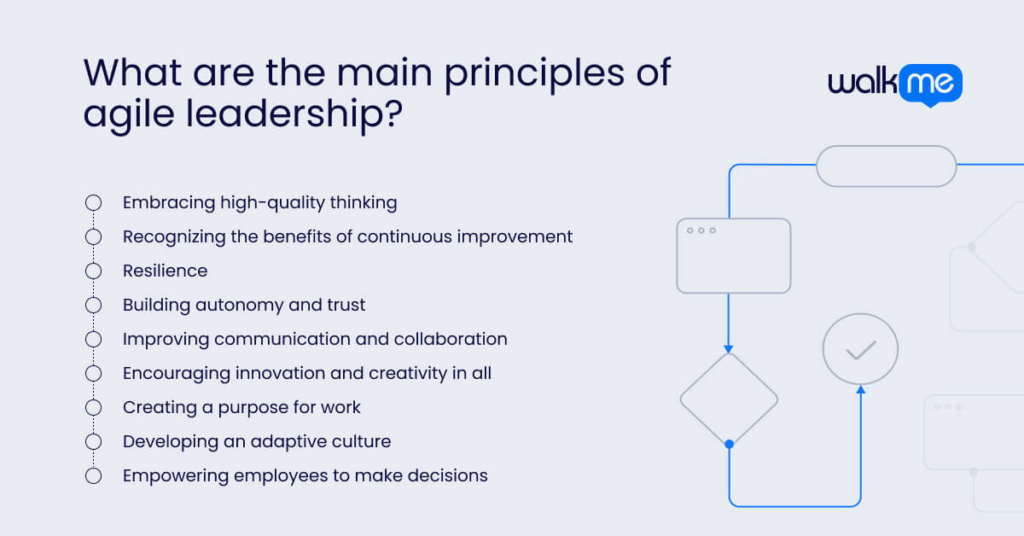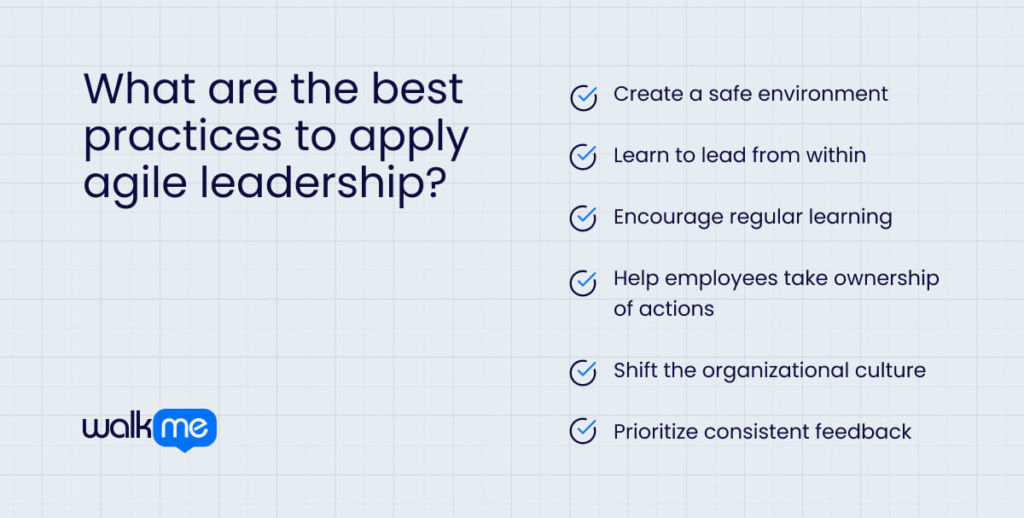Choosing the best leadership style for your business depends on what you do and the tasks. Agile leadership is different from traditional, rigid structures. It views projects as living systems that can adapt to the business’s needs.
With agility at its core, a business can quickly adjust to changes, reprioritize tasks, and keep making progress, leading to increased employee productivity and success.
Many leaders understand business agility for their project teams. However, they often overlook how it applies to them. This article will explore what agile leadership is and its benefits for businesses. It will also discuss how to implement it at your workplace.
What is agile leadership?
Agile leadership is flexible and adaptable to change. It helps teams stay on track by setting small, achievable goals. This approach, which started with software development, is useful in fast-paced industries.
Agile leadership has changed over time, from early tribal systems to modern hierarchies. Frederick Taylor showed that strict rules could be limiting, while Edward Deming emphasized efficiency and worker involvement.
Why is agile leadership important?
Agile leaders are best for dealing with uncertain situations. These leaders have a clear vision, are not afraid to take risks, and can convince others to follow them. They can change as they learn new things. In today’s fast-changing world, things are always changing, which makes it hard for traditional leaders.
Technology is quickly changing markets, businesses, and economies, and few things stay the same. This new economy needs leaders who can deal with uncertainty and react quickly to problems. The ability to notice and change is important for success. Agile leadership is also important for dealing with problems in social, political, and climate systems.
What is the difference between agile and traditional leadership?
The traditional leadership model, the waterfall method, uses a strict top-down structure where plans are made at the beginning, and those in charge make decisions. This inflexible approach makes it difficult for organizations to change quickly. It can also make employees feel bad if their ideas are not listened to.
Agile leadership, on the other hand, helps employees develop their skills by giving them more power. Agile leaders allow teams to work independently and take responsibility. Unlike traditional leaders, they work together to create value and encourage open conversations. They focus on the team’s needs, serve others, and provide learning opportunities. They also keep in touch with customers and colleagues.
What are the main principles of agile leadership?

The main principles of agile leadership that you need to know are:
Embracing high-quality thinking
Agile leaders highly value clear thinking that leads to meaningful action. They examine problems from many angles and seek feedback from all stakeholders. Input from those closest to the problem is important. This helps leaders stay grounded in reality rather than relying solely on data.
Allowing time for deep thinking is also a priority for agile leaders. They focus on the most important tasks at any given moment to ensure effective decision-making.
Recognizing the benefits of continuous improvement
A key part of agile leadership is empowering team members. Agile leaders know that people need a sense of purpose, which comes from working together and always improving. They should encourage constant learning and teamwork.
Failure is also a valuable teacher and helps with continuous improvement. It’s not about celebrating failure but seeing the opportunities it brings for growth.
Resilience
Agile leaders stay calm and keep their teams focused during tough times. They understand the need for balance at work and avoid giving their teams more tasks than they can handle.
Building autonomy and trust
In an agile organization, every employee can take on a leadership role. They often manage parts of a project while working with other team members. Leaders must empower others to take the initiative to build trust.
They give their team members chances to lead projects, even small ones. This could be writing an experiment plan or presenting it to peers.
Improving communication and collaboration
Collaboration and good communication are key to the success of agile leadership. Agile leaders enable cross-functional teams to work closely together, breaking down barriers between departments and fostering shared responsibility.
Open and honest communication is encouraged across the organization, creating strong feedback loops. Emphasizing shared goals, priorities, and expectations helps align team efforts. As a result, teams can make better, more informed decisions.
Encouraging innovation and creativity in all
Agile leaders inspire others to do their best work. They understand that emotions are important in our experiences. When people connect with their emotions, they reach their full potential.
Innovation and creativity grow from the respect agile leaders create by being accessible, open, honest, and transparent. These leaders listen to their colleagues’ thoughts and ideas for improvement. Even if some ideas are not used, they encourage creativity by explaining which ideas worked and which did not.
Creating a purpose for work
Giving work a purpose boosts employee retention and engagement. An agile workplace, with its constant changes, needs a clear mission to motivate employees. For companies in specific industries, leaders can highlight their customers to embed purpose into the organization.
This means asking how adaptability helps serve customers better and improve their lives. An agile organization’s purpose supports its focus on agile leadership.
Developing an adaptive culture
These types of leaders create flexible strategies that can change as circumstances shift. This adaptability is crucial for long-term success in a changing business environment. Promoting continuous improvement and learning from failures allows teams to adapt and succeed during challenges. Teams thrive when they embrace this way of thinking.
Empowering employees to make decisions
Agile leaders expand the idea of empowerment. They give teams not just authority but also the freedom to explore experiments and learn from their results. This flexibility helps teams reach their full potential and unlock new creativity.
What are the best practices to apply agile leadership?

Here are the best practices you need to apply agile leadership:
Create a safe environment
Creating a safe and supportive environment is crucial in agile leadership. Leaders should make team members feel comfortable sharing ideas, taking risks, and learning from failures. This kind of environment fosters creativity and innovation, essential for handling uncertainty.
Teams need a space to brainstorm big ideas and find new solutions to old problems. Leaders guide teams through experiments and provide support. A secure environment allows teams to learn from mistakes and test new ideas.
Even when experiments don’t go well, results should be shared with other departments and senior management.
Learn to lead from within
Agile leaders must have a growth mindset. They should ask for feedback and admit when they are wrong. Training and coaching can help these leaders learn and apply agile principles.
Challenges and failures are welcomed. Mistakes are viewed as chances to learn. Leaders practice kindness toward themselves, balancing the drive for excellence with the understanding that mistakes are part of growth. They know their strengths and weaknesses and set clear goals for self-improvement.
Agile leadership involves applying various types of knowledge to their roles and teams. As role models, they demonstrate adaptability and a commitment to self-growth.
Encourage regular learning
Promote continuous learning and development to help employees grow. Learning opportunities keep teams motivated and encourage open discussions about important topics. Encourage teams to work together across departments to share knowledge, ideas, and feedback.
HR leaders can offer choices for continuous learning. This can include just-in-time training, workshops, or internal knowledge-sharing sessions.
Help employees take ownership of actions
An agile leader makes a place where people work together, have fun, and trust each other. They go above and beyond for customers.
Leaders see employees as experts on the products and how things work. They use this knowledge to make things better. They notice the power of teamwork and learn from it. Telling people what to do doesn’t work in a changing world. It stops people from being creative and working together.
Agile leaders create a place where employees do well. They let employees at all levels make choices, which makes them feel important and helps things happen faster.
Shift the organizational culture
Leaders should help everyone in the organization develop new ways of thinking and acting, even those who do not manage others. Learning should be a part of everyday work.
You need to encourage employees to be creative and focused on discovery. This means looking for different ideas, working together, and trying new things.
Today’s markets change quickly. Leaders must also have a mindset of abundance that recognizes that unlimited resources are available. This approach helps focus on customers, encourages entrepreneurship, includes everyone, and creates things together.
Prioritize consistent feedback
Many people finish a big project and forget to review how it went. Feedback is important in agile leadership. As an agile team leader, make feedback a top priority for your team.
Feedback can come from coworkers, customers, or other project participants. Emphasize the importance of using data to make decisions and try new things.
Teams should use the data they collect to improve the next project. Set aside time for teams to present their data when a project is finished. They should also think about how they did. Discuss what went well and what could be better next time. This way, both the product and the process will keep getting better.
Use an agile leadership approach to help you stay ahead of the curve
Agile leaders are always changing, trying new things, taking chances, and listening to different ideas. They need to think creatively and solve problems. Unlike old-fashioned top-down ways of doing things, which can be slow and hard, agile organizations change their own processes to respond quickly to changes. This helps them stay ahead of their competitors and better meet the needs of employees and customers.
This also makes a good place to work where everyone’s ideas are important, no matter what their job is. This respectful place gives employees power, makes them feel good, and leads to better results and more efficient teamwork.
FAQs
Agile leadership works best to improve employee effectiveness and productivity. It encourages team members to try new methods, quickly test ideas, and improve over time.
Some examples of agile leaders are Daniel EK, founder of Spotify, Steven van Rijswijk, CEO of ING Bank, and Marc Benioff, CEO of Salesforce.
The different types of agile leadership styles are directing, demanding, envisioning, conducting, coaching, and catalyzing.

